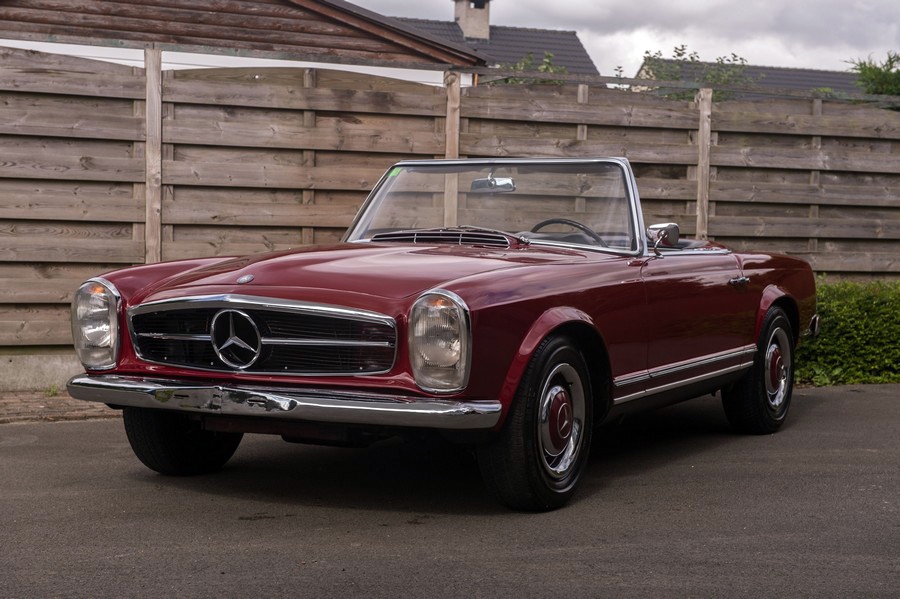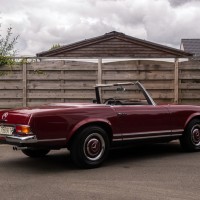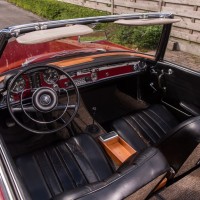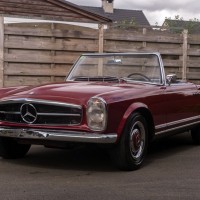SCM Analysis
Detailing
| Vehicle: | 1965 Mercedes-Benz 230SL |
| Number Produced: | 19,831 |
| Original List Price: | $7,469 |
| Chassis Number Location: | Stamped on ID plate on top of firewall inside engine compartment |
| Engine Number Location: | Left side of engine block to rear of the fuel injection pump |
| Club Info: | Mercedes-Benz Club of America |
| Website: | http://www.mbca.org |
| Investment Grade: | B |
This car, Lot 4, sold for €40,250 ($55,009), including buyer’s premium, at Bonhams’ Zoute Sale in Knokke-Heist, Belgium, on October 11, 2013.
Just in the past few years, the Pagodas — the Mercedes-Benz 230SL, 250SL, and 280SL cars built on the W113 chassis from 1963 to 1971 — have become the newest darlings among collectible Mercedes-Benz automobiles. With their predecessors, the 190SL sports roadsters, now priced out of reach of hobby collectors, Pagodas are surging in value.
As a bonus for collectors, Mercedes-Benz maintains inventories of essential parts for these cars.
Timeless, practical cars
Developed in an inspired collaboration among chief engineer Rudi Uhlenhaut, designer Paul Bracq and safety engineer Béla Barényi, these sports touring cars were extremely advanced for their day, and they remain practical and satisfying today. The design is timeless, road manners and ride comfort are exceptional, and even the concave roof was part of the safety package that reduced injury in the event of a collision or rollover.
We think of the Pagodas as a group because there were only very few changes — mainly in engine displacement — during the eight years of production.
The original model, of which our subject car is an example, had a 2,306-cc, 4-cylinder engine producing 150 horsepower and 145 pound-feet of torque. Engine displacement was increased to 2,496 cc in December 1966 by lengthening the cylinder stroke, which resulted in the same horsepower, but increased torque to 159 pound-feet.
Only 5,196 units of the 250SL were produced through the end of 1967 before a new engine with 2,778 cc was introduced, adding 20 horsepower and 20 pound-feet of torque. The 280SL, while least rare of the group, with 23,885 units produced, is most desirable and consequently valuable because of its performance. Fuel efficiency of these cars was unexceptional, rating at approximately 16 mpg.
SL stands for Sports Leicht (sports light), a designation originally applied to the 300SL Gullwing. However, with a curb weight of 3,600 pounds, the Pagoda can’t be considered light — or sporting for that matter. Acceleration was anemic, although a top speed of 120 mph was promised.
But this two-seat convertible was never intended to compete with the Healeys, Porsches, or even Corvettes of the day, and its owners would never have considered taping up the headlamps and going racing for a weekend.
Touring in style
As was established by Albert Finney and Audrey Hepburn in the 1967 movie “Two for the Road,” the car was the perfect accessory for trendy young things to sweep across the landscape and arrive in style at remote inns — with just evening dress, a Paris nightgown and silk pajamas tucked into the optional fitted luggage in the trunk.
The easily operated soft top that tucked neatly under its own hinged tonneau cover was effective and could be supplemented by the snug standard hard top if a winter drive to the ski lodge at Gstaad was contemplated.
The only downside to this automobile is that the rpm is annoyingly high at typical highway speeds with the standard gearing and rear end. That said, the engine is more than adequate to sustain the high revs.
Good news and bad news
But what about our example here? On the one hand, it is equipped with the highly desirable and quite rare 4-speed manual gearbox. Nearly all export models — and most European models — were equipped with a 4-speed automatic, which reflected the wishes of most buyers of this grand touring car in its period. Our example also has the stylish European headlamps intended in the original design, rather than round American headlights.
On the other hand, the pictures in the auction catalog indicate that the car may have been given a quick respray at some point in its lifetime, and it hasn’t been given much recent love. No attention was given to repairing the visible rips in the upholstery — much less detailing the dirty engine compartment.
My guess is that the owner simply thought better of restoring it after bringing it back to Belgium and got an attractive cash offer from a dealer who was taking advantage of the recent surge in interest in the Pagodas and anticipated a quick, profitable flip.
Certainly, at a minimum, if the running gear hasn’t gotten any more attention recently than the upholstery, the new owner is going to need to replace all of the bushings, belts and hoses (low mileage is not necessarily a plus with a Mercedes-Benz). Detailing the engine compartment and getting the upholstery repaired at the same time is a good idea before driving the car any distance.
If the new owner only aspires to have a car to drive and enjoy — and the engine doesn’t need a rebuild — the sale price is fair. However, if a serious mechanical problem does manifest itself, or if a show-quality example is the objective, this buyer is going to quickly long for a recently restored example that would be more of a bargain — even at twice the price of our subject car. ♦
(Introductory description courtesy of Bonhams.)



